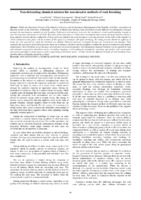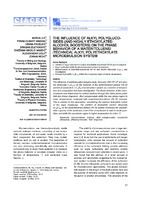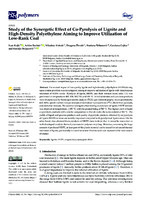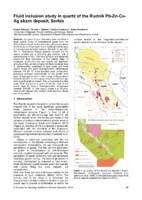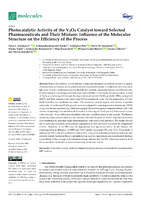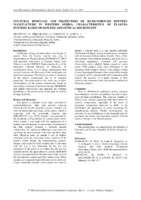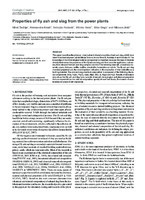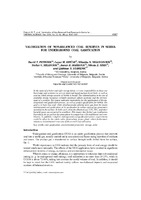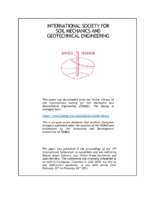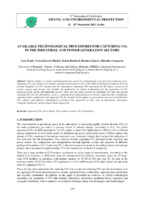Претрага
105 items
-
Non-Detonating Chemical Mixture for Non-Invasive Methods of Rock Breaking
Within the Innovation developed several different non-detonating chemical mixtures for non-invasive methods of rock breaking. Laboratory and polygon tests gave the satisfactory results and knowledge enough to start the practical experiments in the field. The basis of this innovation is a theoretical assumption that certain chemical mixtures release a large quantity of gases during combustion. If these gases are found in the enclosed space a growing pressure on the walls of the chamber in which combustion takes place will ...Lazar Kričak, Milanka Negovanović, Nikola Simić, Stefan Milanović. "Non-Detonating Chemical Mixture for Non-Invasive Methods of Rock Breaking" in X International Scientific Congress Innovations 2024, Varna, Bulgaria, 24-27. jun 2024, Scientific Technical Union of Mechanical Engineering "Industry 4.0" (2024)
-
The influence of alkyl polyglucosides (and highly ethoxylated alcohol boosters) on the phase behavior of a water/toluene/technical alkyl polyethoxylate microemulsion system
Marija Ilic, Franz-Hubert Haegel, Vesna Pavelkic, Dragan Zlatanovic, Snezana Nikolic-Mandic, Aleksandar Lolic, Zoran Nedic (2016)The influence of additives (alkyl polyglucoside, Glucopon 600 CS UP and alcohol ethoxylate C18E100) on the behavior of the water/toluene/Lutensol ON 50 (technical oxoalcohol, i-C10E5) microemulsion system as a function of temperature and composition has been investigated. The phase behavior of the microemulsions was determined by vertical sections through the Gibbs phase prism (fish-like phase diagrams). Alkyl polyglucoside shifts the one phase region to lower temperatures compared with water/toluene/Lutensol ON 50 mixtures. This is contrary to the expectation, considering ...микроемулзија, толуен, алкил полиглукозид, оксоалкохол етоксилат, појачивач ефикасности, „fish“ дијаграми... following composition variables (pressure is always kept constant) - the mass fraction of oil in the mixture of water and oil: 0 = a {(ma + me) () The mass fraction of surfactant in the mixture of all three components in ternary mixtures: = mcel(ma + ma + mc) (2) Oor: ?= (mc + mo)/(Ima + ...
... wider and the efficiency of the surfactant mixture increases slightly. With increasing , the “fish tail! unexpectedly moves downward on the temperature scale despite the hydrophilic nature of the sugar surfactant. The efficiency of the surfactant mixture increases with increasing 6. In these ...
... system | Marija Ilic, Franz-Hubert Haegel, Vesna Pavelkic, Dragan Zlatanovic, Snezana Nikolic-Mandic, Aleksandar Lolic, Zoran Nedic | Chemical Industry and Chemical Engineering Quarterly | 2016 | | 10.2298/CICEQ141105015I http://dr.rgf.bg.ac.rs/s/repo/item/0008425 Дигитални репозиторијум Рударск ...Marija Ilic, Franz-Hubert Haegel, Vesna Pavelkic, Dragan Zlatanovic, Snezana Nikolic-Mandic, Aleksandar Lolic, Zoran Nedic. "The influence of alkyl polyglucosides (and highly ethoxylated alcohol boosters) on the phase behavior of a water/toluene/technical alkyl polyethoxylate microemulsion system" in Chemical Industry and Chemical Engineering Quarterly, National Library of Serbia (2016). https://doi.org/ 10.2298/CICEQ141105015I
-
Laboratory testing of fly ash
Fly ash is one of the most common waste materials created by burning of coal. It is composed of smaller particles, consisting mainly of aluminosilicate glass, mullite and quartz, which are collected by electrostatic separators (filter) of gaseous products arising from the combustion of coal. This paper presents the pozzolanic properties, mechanical properties, chemical and mineral composition of fly ash obtained in the combustion process in a power plant Nikola Tesla A (PPNT A) with the addition of a ...chemical composition, fly ash, mechanical properties, mineral properties, pozzolanic properties, X-ray diffraction... discussion 3.1 The chemical composition of fly ash Results of chemical analysis of fly ash samples taken in Series 1 (S1) and Series 2 (S2) from PPNT A, are shown in Tab. 7. Table 7 Results of chemical analyses of fly ash taken in S1 and S2 at location of PPNT A Chemical composition S1 S2 ...
... additives (hydrated lime and cement) in a humid environment. 2.2 Chemical composition of fly ash Chemical composition of the fly ash from PPNT A was tested in laboratory for concrete and binders in "Highway Institute A. D.". Chemical analysis was performed on samples with volume of 10 g for "Series ...
... 2" (S2). In period from 1983 to 2004, testing of chemical composition was done for 59 samples and results are presented in Tab. 1. Table 1 The results of the chemical composition of ashes from PPNT A for the period from 1983 to 2004 Chemical composition min max mean Ash composition, mass ...Miloš Šešlija, Aleksandra Rosić, Nebojša Radović, Milinko Vasić, Mitar Đogo, Milovan Jotić. "Laboratory testing of fly ash" in Tehnički vijesnik (2016). https://doi.org/10.17559/TV-20150317171035
-
Application of Lignite Combustion Waste Slag Generated in Heating Plants as a Partial Replacement for Cement. Part II: Physical–Mechanical and Physical–Chemical Characterization of Mortar and Concrete
Milan Kragović, Nenad Ristić , Jelena Gulicovski, Andrijana Nedeljković, Snežana Pašalić, Ivica Ristović, Marija Stojmenović (2021)sagorevanje lignita, otpadna šljaka, zamena cementa, proizvodnja maltera i betona, fizičko-mehanička i fizičko-hemijska karakterizacija... Popovac, Serbia. Silica fumes were bought from the company “Sika”. The physical–chemical, chemical and mineralogical composition of the used cement, slag and silica fumes are given in Table 1. Table 1. The physical–chemical, chemical and mineralogical properties of the used cement, slag and silica fumes [16] ...
... appropriate computer software. The test was conducted at the concrete age of 2, 7, 28, and 90 days. 2.3.3. Physical–chemical Characterization of Hardened Mortar Samples The physical–chemical characterization was performed on hardened mortar samples with maximal possible cement replacement (20%) (P-20M) ...
... standard EN 12457-2 on the mortar with 20% of cement replacement. The leaching was carried out on crushed hardened mortar with water by mixing the mixture for 24 h, with the liquid/solid ratio of 10 dm3/kg. The results showed the negligible release of heavy metals whose values were much lower in comparison ...Milan Kragović, Nenad Ristić , Jelena Gulicovski, Andrijana Nedeljković, Snežana Pašalić, Ivica Ristović, Marija Stojmenović . "Application of Lignite Combustion Waste Slag Generated in Heating Plants as a Partial Replacement for Cement. Part II: Physical–Mechanical and Physical–Chemical Characterization of Mortar and Concrete" in Minerals, MDPI (2021). https://doi.org/10.3390/min11090925
-
Study of the Synergetic Effect of Co-Pyrolysis of Lignite and High-Density Polyethylene Aiming to Improve Utilization of Low-Rank Coal
Ivan Kojić, Achim Bechtel, Nikoleta Aleksić, Dragana Životić, Snežana Trifunović, Gordana Gajica, Ksenija Stojanović (2021)... sis of lignite/HDPE mixture at 400 ◦C (experimental yield); Lignite/HDPE 450—pyrolysis of lignite/HDPE mixture at 450 ◦C (experimental yield); Lignite/HDPE 500— pyrolysis of lignite/HDPE mixture at 500 ◦C (experimental yield); Lignite/HDPE 550—pyrolysis of lignite/HDPE mixture at 550 ◦C (experimental ...
... lignite/HDPE mixture pyrolysis at 500 ◦C; Lignite/HDPE 550 (T)—theoretical (calculated) yield of lignite/HDPE mixture pyrolysis at 550 ◦C; Lignite/HDPE 600 (T)— theoretical (calculated) yield of lignite/HDPE mixture pyrolysis at 600 ◦C; theoretical (calculated) yield of lignite/HDPE mixture pyrolysis ...
... Lignite/HDPE 600—pyrolysis of lignite/HDPE mixture at 600 ◦C (experimental yield); Lignite/HDPE 400 (T)—theoretical (calculated) yield of lignite/HDPE mixture pyrolysis at 400 ◦C; Lignite/HDPE 450 (T)—theoretical (calculated) yield of lignite/HDPE mixture pyrolysis at 450 ◦C; Lignite/HDPE 500 (T) ...Ivan Kojić, Achim Bechtel, Nikoleta Aleksić, Dragana Životić, Snežana Trifunović, Gordana Gajica, Ksenija Stojanović. "Study of the Synergetic Effect of Co-Pyrolysis of Lignite and High-Density Polyethylene Aiming to Improve Utilization of Low-Rank Coal" in Polymers, MDPI AG (2021). https://doi.org/10.3390/polym13050759
-
Fluid inclusion study in quartz of the Rudnik Pb-Zn-Cu-Ag skarn deposit, Serbia
Six types of fluid inclusions were identified in three growth zones of hydrothermal quartz from the Rudnik skarn deposit. In the core zone, primary two-phase fluid inclusions of high (type 1) and moderate salinity (type 2) homogenized to liquid between 350-430 °C and 340-420 °C, respectively. Raman analysis revealed that the vapour phases are a CO2-CH4 gas mixture, with a predominance of CO2. The core contains and dispersed vapour-rich fluid inclusions of low salinity (type 3) composed of CO2-CH4-H2S ...Stefan Petrović, Ronald J. Bakker, Vladica Cvetković, Rade Jelenković. "Fluid inclusion study in quartz of the Rudnik Pb-Zn-Cu-Ag skarn deposit, Serbia" in Mineral Resources in a Changing World-17th SGA Biennial Meeting, Zurich, between 28th August and 1st September 2023, Genéve : Society for Geology Applied to Mineral Deposits (2023)
-
Prevent Leakage and Mixture of Karst Groundwater
Milanović Saša, Dragišić Veselin, Radulović Milan M., Stevanović Zoran. "Prevent Leakage and Mixture of Karst Groundwater" in Karst Aquifers – Characterization and Engineering (Stevanović Z. ed), Series: Professional Practice in Earth Science, :Springer International Publishing (2015): 531-600. https://doi.org/10.1007/978-3-319-12850-4_16
-
Numerical Analysis of Lean Premixed Combustor Fueled by Propane-Hydrogen Mixture
Mahjoub Mustafa Makhzoum Ali, Milivojević Aleksandar, Adžić Vuk, Živković Marija, Fotev Vasko, Adžić Miroljub (2017)Mahjoub Mustafa Makhzoum Ali, Milivojević Aleksandar, Adžić Vuk, Živković Marija, Fotev Vasko, Adžić Miroljub. "Numerical Analysis of Lean Premixed Combustor Fueled by Propane-Hydrogen Mixture" in Thermal Science 6 no. 21, Beograd:Institut za nuklearne nauke Vinča (2017): 2599-2608
-
Pyrolysis of lignite, HDPE, and lignite/HDPE mixture
Kojić Ivan, Gajica Gordana, Životić Dragana, Bechtel Achim, Stojanović Ksenija. "Pyrolysis of lignite, HDPE, and lignite/HDPE mixture" in ICCP Program & Abstract Book. 67th Annual Meeting of the International Committee for Coal and Organic Petrology, September 5-11. 2015,, Potsdam, Germany:Schriftenreihe der Deutschen Gesellschaft für Geowissenschaften Heft 87 (2015): 96-97
-
Development of non explosive fuel mixture for non-invasive procedures of obtaining the blocks of decorative stones
Kričak Lazar, Petrović D., Negovanović Milanka, Janković Ivan, Zeković Dario. "Development of non explosive fuel mixture for non-invasive procedures of obtaining the blocks of decorative stones" in Proceedings of the 1st International Conference „ Harmony of nature and spirituality in stone“, Kragujevac, Serbia:Stone Studio Association (2011): 85-89
-
Photocatalytic Activity of the V2O5 Catalyst toward Selected Pharmaceuticals and Their Mixture: Influence of the Molecular Structure on the Efficiency of the Process
Sanja J. Armaković, Aleksandra Jovanoski Kostić, Andrijana Bilić, Maria M. Savanović, Nataša Tomić, Aleksandar Kremenović, Maja Šćepanović, Mirjana Grujić-Brojčin, Jovana Ćirković, Stevan Armaković (2023)Due to the inability of conventional wastewater treatment procedures to remove organic pharmaceutical pollutants, active pharmaceutical components remain in wastewater and even reach tap water. In terms of pharmaceutical pollutants, the scientific community focuses on -blockers due to their extensive (over)usage and moderately high solubility. In this study, the photocatalytic activity of V2O5 was investigated through the degradation of nadolol (NAD), pindolol (PIN), metoprolol (MET), and their mixture under ultraviolet (UV) irradiation in water. For the preparation of V2O5, facile ...DFT analysis, metoprolol, nadolol, nanomaterial characterization, photocatalysis, pindolol, β-blocker... MET and NAD. Further, the mixture of NAD, PIN, and MET was subjected to DF and a photocatalytic reaction with V>Os to study their degradation when coexisting in environmental waters, as it occurs in nature. As seen in Figure 12a, exposure of the NAD, PIN, and MET mixture to UV did not cause a higher ...
... and MET mixture degradation kinetics under UV irradiation: (a) without VOs and (b) with V»Os catalyst. 9.00 MDF W Photocatalysis 8.00 7.00 6.00 „. 500 — 4.00 3.00 2.00 1.00 0.00 0 5 10 30 60 ~ 120 Time (min) Figure 13. pH values during, NAD, PIN, and MET mixture degradation ...
... Измењено: 2023-10-16 07:40:29 Photocatalytic Activity of the V2O5 Catalyst toward Selected Pharmaceuticals and Their Mixture: Influence of the Molecular Structure on the Efficiency of the Process Sanja J. Armaković, Aleksandra Jovanoski Kostić, Andrijana Bilić, Maria M. ...Sanja J. Armaković, Aleksandra Jovanoski Kostić, Andrijana Bilić, Maria M. Savanović, Nataša Tomić, Aleksandar Kremenović, Maja Šćepanović, Mirjana Grujić-Brojčin, Jovana Ćirković, Stevan Armaković. "Photocatalytic Activity of the V2O5 Catalyst toward Selected Pharmaceuticals and Their Mixture: Influence of the Molecular Structure on the Efficiency of the Process" in Molecules, MDPI AG (2023). https://doi.org/10.3390/molecules28020655
-
Cultural Heritage and Protection of Hand-Wheeled Pottery Manufacture in Western Serbia: Characteristics of Zlakusa Pottery Based on Sem-Eds and Optical Microscopy
... applying the obtained knowledge in the preservation of this type of cultural heritage in Serbia. Results and discussion Clay paste is a mixture of raw clays, consisted of kaolinite/halloysite, illite and smectite minerals followed with smaller amounts of quartz, feldspar and iron oxy ...
... samples are compared slight difference can be observed. Larger, randomly oriented calcite grains are noted in sample 1. Ground mass is a clay mixture uniformly distributed with larger, mostly rounded pores, consistent with microscopical observations. Sample 2 has a fluid- like structure where ...
... 2, except K and Ca. Amount of K and Ca elements could indicate the presence of a higher amount of illite minerals and carbonates in the clay mixture which is not following sample 1. Conclusion How to differentiate traditional pottery products from imitations was the real problem because ...Milošević Maja, Zdravković Alena, Đordjević Biljana, Jelić Ivana. "Cultural Heritage and Protection of Hand-Wheeled Pottery Manufacture in Western Serbia: Characteristics of Zlakusa Pottery Based on Sem-Eds and Optical Microscopy" in 8th Mineral Sciences in the Carpathians Conference, Acta Mineralogica-Petrographica, Miskolc, Hungary, Department of Mineralogy, Geochemistry and Petrology, University of Szeged, Szeged, Hungary (2021)
-
Properties of fly ash and slag from the power plants
This paper describes the physical, chemical and mineral properties of ash and slag, which were taken from thermal power plants Nikola Tesla A, Nikola Tesla B, Kostolac A and Kostolac B. The knowledge of the mineralogical material composition is important because the type of minerals directly determines the properties of the fly ash and slag and their possible application. Laboratory tests showed that ash and slag samples consist of the following minerals: amorphous materials, quartz, feldspar, mullite, melilite, cristobalite, ...fly ash, slag, physical composition, chemical composition, mineral composition, X-ray diffraction method... Most of the research is based on an examination of the chemical composition of the ash (THOMAS, 2007; KIM et al., 2005), the mineral ash composi- tion (ŽIVOTIĆ et al., 2015), the mineral ash and coal composition (WARD & FRENCH, 2005) and chemical-mineral ash composi- tion (VASSILEV et al., 2013; VASSILEV ...
... There are many papers of narrower scope that establish correlations between the chemical, mineral and physical properties of fly ash (VASSILEV & VAS- SILEVA, 2007). Based on the most common characteristics (chemical and mineral composition) of ash and slag from the Ko- lubara and Kostolac coal basins ...
... mullite, melilite, cristobalite, haematite and calcite. The fly ash and slag chemical properties are the most important indicators in the evaluation of their suitability as a building material. The ash and slag chemical composition is composed of the following chemi- cal components: SiO2, Al2O3, Fe2O3 ...Miloš Šešlija, Aleksandra Rosić, Nebojša Radović, Milinko Vasić, Mitar Đogo, Milovan Jotić. "Properties of fly ash and slag from the power plants" in Geologia Croatica, Zagreb : Croatian Geological Survey (2016). https://doi.org/10.4154/gc.2016.26
-
Valorization of non-balanced coal reserves in Serbia for underground coal gasification
David Petrović, Lazar Kričak, Milanka Negovanović, Stefan Milanović, Jovan Marković, Nikola Simić, Ljubisav Stamenić (2019)In the name of a better and safer energy future, it is our responsibility to focus our knowledge and activities to save on imported liquid and gas fossil fuels, as well as coal on which energy security of Serbia is based. The rationalization in the use of available energy resources certainly positively affects economy and the environment of a country. This paper indicates motivations for the application of the underground coal gasification process, as well as surface gasification for ...... separate CO, from the gas mixture of UCG, and its possible storage carbon capture and storage, depends on the technological development of the separation and storage of CO [3]. Syngas can be used to produce a number of usable products, such as electricity, liquid fuels and chemical raw materials. The ...
... elevated pressures and temperatures (in particular with the current UCG systems), CH, is also present. Generated gas mixture is similar to natural gas. If a vapor-oxygen mixture is used as a gasification agent instead of air, the optimal ratio should be about 7-8 kg of steam per m? of O». If only ...
... Exothermic reactions (at f > 600 "C) are predominantly occurring in UCG process, and the resulting gas mixture can contain 8-20% CO», 5-20% CO, 10-20% H», and 2-5% CHoa. Ifthe gas mixture contains too much CO., and possibly water vapor, the UCG gas (syngas) can Petrović, D. T., et al.: Valorization ...David Petrović, Lazar Kričak, Milanka Negovanović, Stefan Milanović, Jovan Marković, Nikola Simić, Ljubisav Stamenić. "Valorization of non-balanced coal reserves in Serbia for underground coal gasification" in Thermal Science (2019). https://doi.org/10.2298/TSCI190725390P
-
Numerical modeling of Selanac debris flow propagation using SPH code
The Selanac debris flow is a very huge event triggered after extreme rainfall caused by Cyclone Tamara activity in the Republic of Serbia in May 2014. The Selanac case study was already modelling in different programs using Voellmy rheology assumptions like RAMMS software. In this paper research are focusing particularly on the process of debris flowing from initiation zone to main deposition area using Geoflow SPH two-phase model considering frictional rheology law. Main rheological parameters are back-calculated using also ...... mud. If the shear resistance of the fluid phase can be neglected, the stress tensor in the mixture can be decomposed into a ‘pore pressure’ and an effective stress, and the mechanical behavior of the mixture can be described by a system of differential equations governing the dynamics of each of ...
... Pastor et al. (2009) considering: A. balance of mass of the mixture—propagating along the slope and increasing due to bed entrainment—combined to the balance of linear momentum of pore water, B. the balance of linear momentum of the mixture, C. a kinetic relation between the deformation-rate tensor ...
... surface problems, as the complex re- meshing process is avoided. The SPH model proposed by Pastor et al. (2009), defines propagations of mass as mixture of soil and water particles with calculation of velocity. In addition, calculation of pore water pressures propagation is possible to be obtained ...Jelka Krušić, Biljana Abolmasov, Miloš Marjanović, Manuel Pastor, Saeid M. Tayyebi . "Numerical modeling of Selanac debris flow propagation using SPH code" in SCG-XIII International Symposium on Landslides. Cartagena, Colombia- February 22-26, 2021, International Society for Soil Mechanics And Geotechnical Engineering (2021)
-
Hydrogeochemical approach to estimate the quality of bottled waters in Serbia
Marina Ćuk, Maja Todorović, Jovana Šisović, Jana Štrbački, Jakov Andrijašević, Petar Papić. "Hydrogeochemical approach to estimate the quality of bottled waters in Serbia" in Chemical Industry, National Library of Serbia (2015). https://doi.org/10.2298/HEMIND150325042C
-
Effects of production conditions on the properties of limestone briquettes aimed for acid soil liming
Vladimir Jovanović, Dragana Nišić, Vladimir Milisavljević, Dejan Todorović, Dragan Radulović, Branislav Ivošević, Sonja Milićević (2022)Vladimir Jovanović, Dragana Nišić, Vladimir Milisavljević, Dejan Todorović, Dragan Radulović, Branislav Ivošević, Sonja Milićević . "Effects of production conditions on the properties of limestone briquettes aimed for acid soil liming" in Chemical Industry (2022). https://doi.org/10.2298/HEMIND220211011J
-
Influence of mono- and two-component organic modifiers on determination of lipophilicity of tetradentate Schiff bases
Ispitivani su uticaji primene mono- i dvokomponentnih organskih modifikatora na određivanje lipofilnosti 12 tetradentatnih Šifovih baza metodom reverzno-fazne tankoslojne hromatografije. Osnovni cilj je da se proceni tip interakcije između posmatranih jedinjenja i komponenti primenjenih hromatografskih sistema i uspostavi neki obrazac ponašanja kako bi se lakše izabrala kombinacija organskih modifikatora koji će simulirati interakciju u biološkim sistemima na osnovu činjenica da iste osnovne intermolekularne interakcije su odgovorne za ponašanje supstanci i u biološkom i u hromatografskom sistemu. Primenjeni organski modifikator ...Nikola Stevanović, Aleksandar Mijatović, Aleksandar Lolić, Mario Zlatović, Rada Baošić. "Influence of mono- and two-component organic modifiers on determination of lipophilicity of tetradentate Schiff bases" in Chemical Papers, Springer Science and Business Media LLC (2021). https://doi.org/10.1007/s11696-021-01884-5
-
Available technological procedures for capturing CO2 in the industrial and power generation sectors
Climate change is a major environmental issue caused by anthropogenic emissions of greenhouse gases. Capturing CO2 and storing it in suitable geological formations is one of the main technological solutions that can provide mitigation of CO2 emission into the atmosphere. Capturing CO2 represents the first phase in process of carbon capture and storage, and includes the application of various technologies for the separation of CO2 produced in the energy and industrial sectors. There are four main systems for capturing ...... The parameters that influence gas separation performance are: membrane material, the share of CO2 in the mixture and the process conditions [21,29]. Increased concentration of CO2 in the mixture increases the separation efficiency [11]. Different types of membrane materials such as polymeric, ceramic ...
... pressure to achieve CO2 capture capacity, the main disadvantage is great amount of energy needed to compress feed gas [18, 20]. Chemical absorption represents chemical reaction between CO2 and a solvent, and it is mainly applied for capturing CO2 in post-combustion systems [18]. Typical solvents for ...
... 10.011. 25. Wang, M.; Lawal, A.; Stephenson, P.; Sidders, J.; Ramshaw, C.; & Yeung, H. Post-combustion CO2 Capture with Chemical Absorption: A State-of-the-art Review. Chemical Engineering Research and Design 2011, 89 (9), 1609-1624. 26. Webley, P.A. Adsorption technology for CO2 separation and ...Lola Tomić, Vesna Karović Maričić, Dušan Danilović, Branko Leković, Miroslav Crnogorac. "Available technological procedures for capturing CO2 in the industrial and power generation sectors" in 8th International Conference Mining and Environmental Protection, 22 – 25th September 2021, Serbia, Univerzitet u Beogradu, Rudarsko-geološki fakultet (2021)
-
Polymorphism and photoluminescence properties of K3ErSi2O7
alkalni silikati elemenata retkih zemalja, silikati lantanoida, polimorfizam, fotoluminescencija, kristalna strukturaPredrag Dabić, Marko G. Nikolić, Sabina Kovač, Aleksandar Kremenović. "Polymorphism and photoluminescence properties of K3ErSi2O7" in Acta Crystallographica Section C Structural Chemistry, International Union of Crystallography (IUCr) (2019). https://doi.org/10.1107/S2053229619011926
